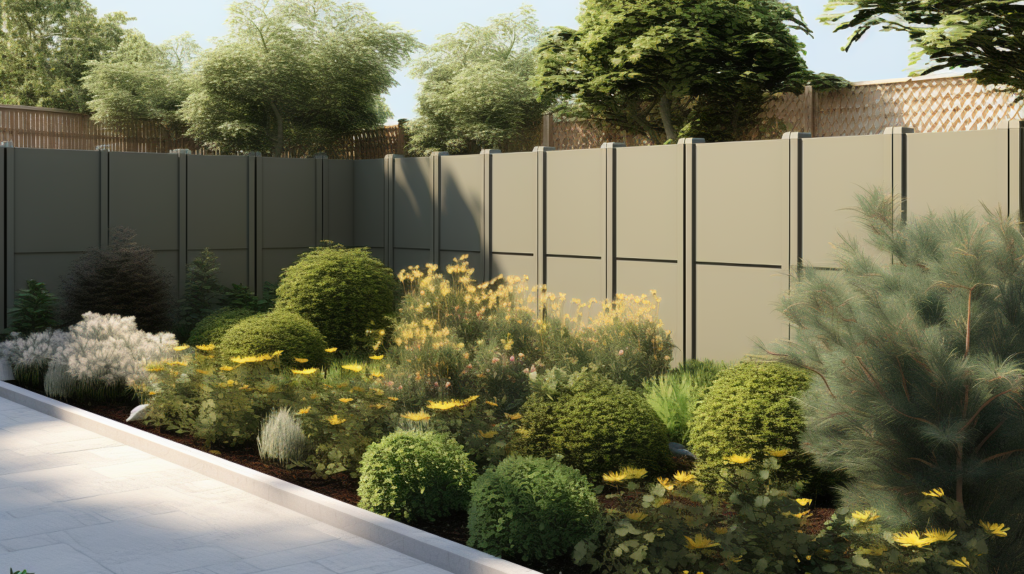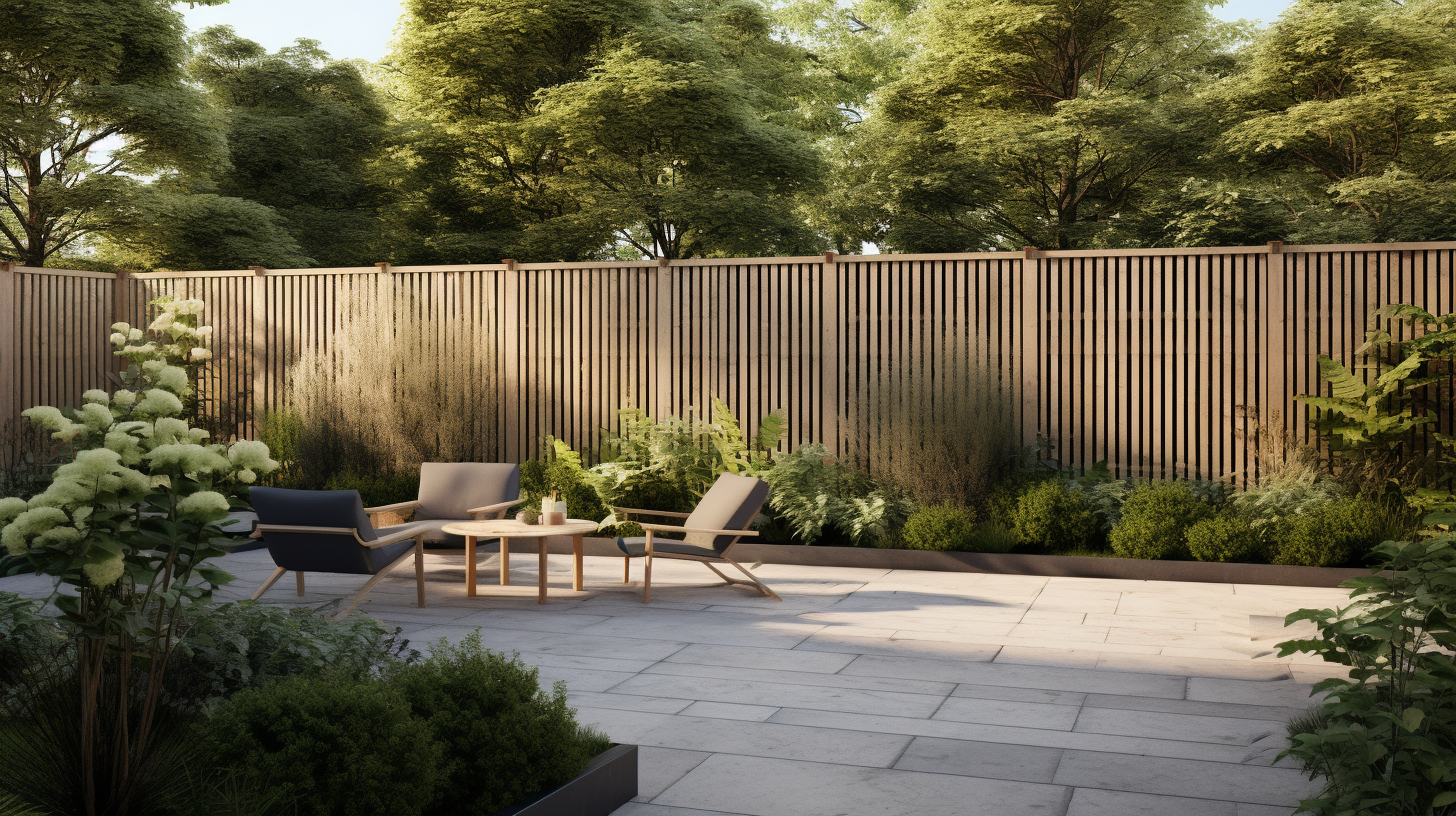Do barking dogs, loud construction and traffic noise make your garden more stressful than relaxing? Take back your outdoor oasis with acoustic fencing.
Acoustic fencing strategically installed around your garden’s perimeter can effectively block external sounds for a noise-reduced sanctuary.
Let’s dive into how purpose-built acoustic barriers can reduce noise pollution and restore tranquility when you want to unwind outdoors.
Why Use Acoustic Fencing to Soundproof Your Garden

Acoustic fencing is an effective and cost efficient method to reduce noise pollution in your garden space.
Compared to options like sound absorbing plants or white noise machines, installing a purpose-built acoustic barrier fence around your garden perimeter provides an immediate solution to cut out external noise.
Acoustic fencing materials like concrete and bamboo have properties that help absorb and diffuse sound waves rather than letting them freely pass through.
This allows you to create a tranquil oasis right in your own backyard, blocking out disruptive sounds from nearby traffic, neighbors, construction sites or other unwanted noise.
With acoustic fencing built taller than the sources of noise pollution, you can eliminate them almost entirely from your garden.
The density of the fencing material also plays an important role in sound blocking – the more solid and heavy, the less noise will permeate through.
Acoustic fencing creates a physical barrier that sound waves cannot easily penetrate.
This differs from other noise reduction methods that aim to mask or absorb sounds after they have already entered the space.
The fence blocks the noise at the source, stopping it from ever reaching your garden.
Choosing the Right Acoustic Fencing

When installing acoustic fencing, the height is a key consideration to make it effective against reducing noise – the fence should be at least 1 meter taller than the source you want to block out.
This prevents sounds from simply passing over the top into your garden space.
A busy highway may produce noise at a height of 3-4 meters, so your acoustic barrier fence should measure at minimum 5 meters tall.
This provides that extra buffer so sounds do not simply pass over the fence top and still pollute your garden oasis.
The density of the fencing material also matters when aiming to optimize sound absorption and diffusion.
Concrete, bamboo and other heavier materials will block more external noise compared to light wood or metal.
Density prevents noise from vibrating through the material itself and leaking into the garden that way. Heavier materials sustain fewer vibrations, cutting down on sound transmission.
Lightweight materials reverberate more with the sound waves, still passing on some of that audible energy into your space.
Angling the top of the fence to slope inward down into the garden also helps scatter sound waves downward rather than letting them travel over.
The angled portion diffuses the noise so it bounces off in different directions rather than maintaining integrity right over the fence.
This added scattering boosts noise reduction. Completely sealing any gaps or holes in the fencing construction is also crucial to prevent noise leakage.
Even small openings around gates, at the ground level or where fence materials meet can degrade acoustic performance, as sounds leak right through.
Use weatherproof sealing products around all joints and gates to cut down on potential gaps.
Positioning Acoustic Fencing Strategically

For maximum noise reduction, acoustic fencing should fully envelope the garden perimeter. This eliminates any openings where unwanted sounds can enter from the sides or rear.
Fencing off just one portion of your garden can leave you exposed elsewhere.
Running acoustic fencing along all edges of your property removes any weak points and seals the entire space against intruding noise.
Strategically position fencing along the side facing the source of the most bothersome noise, like busy traffic or a loud neighbor.
This shields the bulk of the sound and prevents it from entering your space. Face any talkers, construction sites or other directional nuisance noise and place the acoustic barrier directly in the path.
This blocks the bulk of noise by stopping it right where it originates.
Fencing along the rear is also important to block noises that may come from behind the garden.
Noise can bounce and travel in tricky ways, so sealing off the rear guards against any indirect sound paths that could reach your space.
Completely sealing off all sides creates the ideal soundproof oasis. Make sure to also measure the height along all fencing, ensuring it surpasses the tallest noise sources.
Combining Fencing with Additional Barriers

While acoustic fencing alone provides excellent noise blocking, some additional elements can enhance the sound dampening abilities even further.
Adding insulation like mass loaded vinyl or acoustic foam inside fences boosts sound absorption.
The foam or insulation acts as an additional buffer to further muffle noises that manage to permeate the fence exterior.
The material soaks up some of the residual sound waves that may otherwise reflect off the inner fence and back into the garden space.
Secondary perimeter fences create an additional barrier that sound must penetrate through. Building another acoustic fence a few feet behind the exterior fence essentially doubles the sound protection.
It forces noise to get through two solid fences rather than just one. This can noticeably cut down on decibel levels reaching your garden sanctuary.
Low shrubs planted along the base of the fence help scatter noise. They add a natural element that creates uneven ground for the sound waves to traverse.
This diffuses the waves so less distinct noise makes it over the barrier. Dense shrubs with thick foliage work best to impair noise pathways.
Noise diffusing panels attached to the exterior fence surface also redirect sound waves away from the garden.
These angled panels literally aim the noise away rather than absorbing it. This further reduces the concentration of direct noise entering your space.
Diffusion is an excellent enhancement for rigid barriers like concrete fences.
Maintaining Acoustic Fencing Over Time

Like any structure, acoustic fencing requires regular inspection and maintenance to keep noise blocking performance optimal over many years.
The initial installation provides robust noise reduction, but you must upkeep the fence integrity to prevent degradation.
Check for cracks, holes or gaps in the materials and immediately seal these to prevent sound leakage. Even minor openings will compromise acoustic abilities over time.
Listen closely while walking along the fence perimeter to detect where outside noise may be leaking through. Seal these spots with caulking or weather stripping to restore soundproofing capacity.
Keep concrete, bamboo and other fencing materials clear of accumulated dust, dirt and debris which can degrade acoustic abilities over time.
Pressure wash periodically to restore the clean, tight surface that optimally scatters sound. Avoid chemical cleaners which may damage materials.
Replace any damaged slats, panels or sections right away to maintain integrity. Never leave cracked or missing pieces unresolved, as this compromises noise blocking across entire sections.
It is better to immediately replace damaged portions rather than waiting and allowing larger issues to occur.
For wood fences, periodically re-treat with sealants to prevent the material losing density. Weathering can cause wood to crack, warp and become less soundproof over time.
Sealants protect the wood and maintain the robust density needed to scatter noise.
Inspect gates, latches and moving parts often for smooth operation and full closure. Fix any sagging gates to prevent sound leakage through gaps.
Lubricate hardware to avoid grinding, squeaking noises which could be audible in your garden.
Check that ground level gravel or turf abutting the fence foundation still fully seals any potential gaps where sound could leak through.
Over time, erosion and sinking can cause the tiniest of ground level holes to develop. Renew ground coverage and use weatherproof caulking to seal any foundation openings.
With proper construction, positioning and care, acoustic fencing can provide lasting noise control for your garden retreat for many years.
Consistent maintenance will protect your investment and let you enjoy a peaceful, tranquil backyard far from the noises of everyday life.
The fence becomes an essential asset for improving your quality of life at home.
Conclusion
Acoustic fencing provides an affordable and effective method to reduce noise pollution in your garden.
With proper installation, strategic placement, and ongoing maintenance, the fence creates a barrier that blocks unwanted sounds from infringing on your outdoor sanctuary.
While initial construction requires an investment, the long-term benefits of lower noise and greater relaxation in your yard make acoustic fences well worth the effort.
The difference a soundproofed garden can make to your everyday peace and wellbeing is priceless.
